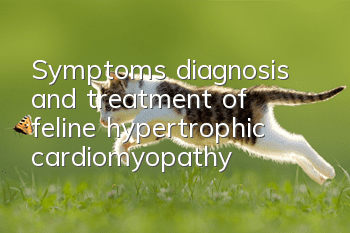Symptoms, diagnosis and treatment of feline hypertrophic cardiomyopathy

One cat named Tabor appears to be smart, alert, responsive and well hydrated. Visual mucosal color and capillary refill time were normal. Chest auscultation revealed a grade 2/6 systolic heart murmur with the strongest point at the base of the left heart. Respiratory rate is normal. There were no obvious abnormalities on lung auscultation. Heart rate is 160-210 beats per minute. Weight 11 lbs. The rest of the physical examination was within normal limits.
1. Evaluation of feline hypertrophic cardiomyopathy
The differential diagnosis of Tabor heart murmur includes benign flow-related heart murmurs, cardiomyopathy, and congenital heart disease.
2. Diagnostic plan for feline hypertrophic cardiomyopathy
Blood routine, full set of biochemistry and T4, and chest X-ray.
3. Laboratory examination of feline hypertrophic cardiomyopathy
The blood routine, biochemistry and T4 results were all within the normal range.
4. Chest X-rays of cats with hypertrophic cardiomyopathy
The chest X-ray showed suspicious global heart enlargement, but the pulmonary blood vessels and lung parenchyma images were within normal limits.
5. Additional testing
Take plasma samples and send them to relevant laboratories to test NTproBNP concentration. A follow-up checkup was scheduled to measure blood pressure before Tabor did any other tests. An echocardiogram was also performed during that review.
5.1 Plasma NTproBNP concentration results
The result is 135 pmol/L. This indicator is elevated, consistent with the results of heart disease examinations. Therefore, Tabor's veterinarian believed that an echocardiogram was necessary to evaluate Tabor's heart disease. Several recent studies have shown that NTproBNP concentrations differ in healthy cat controls, asymptomatic cardiac disease, and congestive heart failure. Therefore, this test can be used clinically as an initial screening test for cats suspected of having heart disease. In addition, this test can help identify whether a cat's dyspnea is respiratory or cardiac in origin.
5.2 Blood pressure
Tabor’s blood pressure was measured with a Doppler sphygmomanometer, and the result was within the normal range (150mmHg, calculated as the average of 5 measurements in a quiet room).
5.3 Cardiac ultrasound findings
Figure 1-3 shows left ventricular hypertrophy. (This is not a quantitativeThe best window for measurement, but wall thickness measured in short-axis view m-ultrasound is 6.5mm). There was evidence of asymmetric hypertrophy of the interventricular septum; dynamic left ventricular outflow tract obstruction (presence of systolic anterior mitral leaflet motion [SAM]) and associated mitral insufficiency was documented.
Figure 1 Two-dimensional long-axis section shows left ventricular free wall thickening (line) and asymmetric ventricular septal hypertrophy during diastole (arrow)
Figures 2 and 3 show a portion of the mitral valve causing dynamic obstruction of the left ventricular outflow tract.
This obstruction causes turbulence in the left ventricular outflow tract, forming a heart murmur. Displacement of the mitral valve leads to secondary insufficiency and ultimately mitral regurgitation. There was also left atrial enlargement.
Figure 2 Two-dimensional long axis section view shows a captured frame of systolic period
Part of the mitral valve is seen being sucked into the left ventricular outflow tract (arrow). This results in turbulence in the outflow tract. Displacement of the mitral valve can lead to secondary insufficiency. These changes are associated with hearing heart murmurs.
Figure 3 A two-dimensional long-axis section showing a captured frame of systole.
In this image, the color Doppler signal is shown. We see turbulence in the left ventricular outflow tract (characterized by a speckled color pattern). A signal of mitral regurgitation (MR) is also seen, most likely the result of mitral valve displacement.
6. Final diagnosis
This is a classic manifestation of feline obstructive hypertrophic cardiomyopathy (HCOM). A component of obstruction, identified by the presence of forward motion of the anterior mitral valve leaflet during systole, is also common in this disease (occurring in >60% of cases).
Heart murmurs are usually discovered incidentally during physical examination. In this case, elevated NTproNBP concentrations supported the presence of cardiac disease, which was confirmed by subsequent echocardiography.
7. Management recommendations for feline hypertrophic cardiomyopathy
The treatment of cats with asymptomatic cardiomyopathy is controversial, and to date, there is no consensus on management. Currently, there is no evidence to support that treatment delays disease progression or onset of clinical symptoms, or improves prognosis.
Some cardiologists will not recommend treatment, while others may advocate treatment. Due to the presence of dynamic left ventricular outflow tract obstruction, a beta-blocker such as atenolol can be used once or twice daily to achieve a resting heart rate between 160 and 180 beats per minute. Calcium channel blockers may be considered because of significant left ventricular hypertrophy. Angiotensin-converting enzyme (ACE1) inhibitors may be considered because of left atrial enlargement. The cardiologist may prescribe angiotensin-converting enzyme inhibitors and calcium blockers or β-Combination of receptor blockers.
The interval between reexaminations is subjective. If beta-blockers are given, it is reasonable to return the cat for review in 1-2 weeks to assess heart rate and adjust dosage accordingly. Many cardiologists will review the echocardiogram after 6 to 12 months. Chest x-rays are needed when cats have clinical signs of congestive heart failure (eg, rapid breathing, difficulty breathing, coughing, or syncope).
Currently, the value of measuring NTproBNP concentration is still under investigation. More research is needed to determine whether increasing NTproBNP concentrations are associated with disease progression or, alternatively, stable or decreasing NTproBNP concentrations occur in well-managed cases.
Although managing Tabor's heart condition has not been simple, Tabor's owners now realize he has heart disease. They may be instructed to monitor it more closely to watch for signs suggestive of congestive heart failure (eg, increased respiratory rate, dyspnea, cough, exercise intolerance, or lethargy). If clinical signs are detected, Tabor owners will know they should seek veterinary help immediately.
- How to train a cat? Training courses suitable for kittens!
- Do cats need to trim their feet? What are the benefits of trimming your cat’s feet?
- Why does the cat keep having diarrhea?
- What is the healthiest thing for kittens to eat?
- Is there a problem with kittens sneezing? Problems with cats sneezing!
- Cat ear mites come back again and again. How to cure cat ear mites?
- What age is the best age for cats to be weaned?
- Why are Siberian cats not suitable for keeping in cities?
- How do Siamese cats tell when they are in estrus?
- When is the best time to neuter a British longhair cat?



